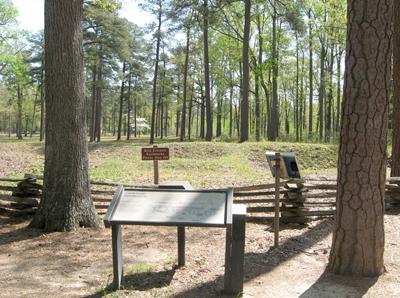Bridging History and Ecology: Fire Management Strategies at Cold Harbor Battlefield
In the heart of Virginia, where rolling hills and historic landscapes intertwine, the Cold Harbor Battlefield stands as a solemn reminder of the sacrifices made during one of the Civil War’s fiercest confrontations. But beyond its historical significance, this hallowed ground is also a focal point for innovative ecological management practices. The National Park Service is now pioneering fire management strategies that aim to preserve both the battlefield’s rich legacy and its natural ecosystem. By embracing a holistic approach that integrates the lessons of history with the principles of ecological stewardship, Park Service officials are forging a path that respects the past while safeguarding the future. As we delve into the complexities of fire management at Cold Harbor, we uncover a story that highlights the intricate relationship between history and ecology, revealing how careful stewardship can honor the memories of those who fought here while nurturing the land they once roamed.
Bridging the Past and Present: The Role of Fire Management in Preserving Cold Harbor Battlefield
At Cold Harbor Battlefield, the intersection of military history and ecology is vividly embodied through proactive fire management strategies. As a site of significant Civil War conflict, maintaining the battlefield’s integrity involves not just historical preservation but also a commitment to natural resource management. Fire management plays a critical role in this dual mission by restoring and conserving native ecosystems while ensuring that the landscape accurately reflects its historical context. Through prescribed burns and strategic fire breaks, park officials aim to promote the growth of native plant species, which not only support local wildlife but also help to maintain the visual characteristics of the battlefield that were present during the era of the battle.
These practices are guided by a clear set of objectives, aimed at striking a balance between preservation and ecological health. Key strategies include:
- Enhancing Biodiversity: Controlled burns encourage the regrowth of native flora, providing habitat for diverse species.
- Reducing Invasive Species: Effective fire management limits the spread of invasive plant species that threaten the historical landscape.
- Maintaining Historical Landscapes: Fire management reflects the land’s historic usage patterns, allowing visitors to experience the battlefield as it was in the 1860s.
To further illustrate the impacts of fire management, a recent assessment by the National Park Service highlighted the benefits observed over the past few years:
| Year | Acres Burned | Species Recovery Index |
|---|---|---|
| 2021 | 50 | 75% |
| 2022 | 40 | 85% |
| 2023 | 30 | 90% |
This strategic approach not only conserves the battlefield’s historical essence but also enhances its ecological resilience, ensuring that Cold Harbor remains a point of reflection for both history enthusiasts and nature lovers alike.
Ecological Impacts of Fire: Strategies for Enhancing Biodiversity at Cold Harbor
The ecological landscape of Cold Harbor Battlefield is deeply intertwined with its historical significance, where fire plays a pivotal role in maintaining and enhancing biodiversity. The landscape, shaped by both natural fire regimes and human activity, necessitates a strategic approach to fire management that recognizes its benefits. Effective fire management practices not only mimic indigenous burning techniques but also promote the regeneration of native flora and fauna. Implementing prescribed burns can help reduce invasive species, increase habitat diversity, and restore ecological balance. These techniques enable park managers to create a mosaic of different habitats that supports a variety of species.
To strengthen biodiversity at Cold Harbor, several strategies will be crucial:
- Prescribed Burning: Scheduled burns that replicate historical fire patterns.
- Invasive Species Control: Targeting non-native species through fire and follow-up measures.
- Habitat Restoration: Refocusing efforts on areas most affected by erosion and habitat loss.
- Community Involvement: Engaging local stakeholders in fire management initiatives to foster a collective sense of stewardship.
As part of the ongoing conservation efforts, understanding the delicate interplay between fire, history, and ecology is critical. Below is a simple overview of the proposed fire management timelines:
| Strategy | Action | Timeline |
|---|---|---|
| Prescribed Burn | Reduce fuel loads, promote growth | Spring & Fall |
| Monitoring & Assessment | Evaluate ecosystem changes | Ongoing |
| Community Workshops | Educate and engage the public | Quarterly |
| Invasive Species Removal | Identify and eliminate non-native species | Summer |
| Restoration Projects | Replant native species, restore habitats | Fall & Winter |
By implementing these strategies, Cold Harbor Battlefield can ensure a thriving ecosystem that honors both its historical context and ecological integrity. Engaging the community and fostering a greater understanding of fire’s role in this landscape will be crucial for sustained success and biodiversity enhancement.
Recommendations for Future Practices: Integrating Historical Integrity with Modern Fire Management Techniques
As the National Park Service continues to address the unique challenges of fire management within the Cold Harbor Battlefield, embracing a multifaceted approach becomes crucial. By integrating historical preservation with contemporary ecological methods, the management strategies can effectively mitigate fire risks while respecting the battlefield’s significance. Recommended practices include:
- Collaborative Workshops: Engage historians, ecologists, and fire management professionals in regular workshops to enhance understanding and communication.
- Controlled Burns with Historical Context: Implement prescribed burns that not only serve ecological purposes but also mirror historical fire patterns that influenced the landscape during the Civil War.
- Public Education Initiatives: Develop programs that educate visitors about the historical implications of fire and its ecological importance, fostering a deeper appreciation for both heritage and nature.
Additionally, data collection and analysis play a pivotal role in ensuring that fire management practices are both effective and historically informed. Utilizing advanced technologies such as GIS mapping and drone surveillance can enhance monitoring efforts. Proposed strategies include:
| Technology | Benefit |
|---|---|
| GIS Mapping | Allows for precise tracking of fire behavior and historical preservation areas. |
| Drone Surveillance | Offers real-time aerial footage for informed decision-making during fire events. |
| Ecological Modeling Software | Predicts fire spread patterns based on historical and current vegetation data. |
To Conclude
As the National Park Service continues to cultivate a deeper understanding of the interwoven narratives of history and ecology at Cold Harbor Battlefield, the implementation of targeted fire management strategies stands as a testament to innovative conservation practices. These efforts not only honor the sacrifices made on this hallowed ground, but also foster a resilient ecosystem that reflects the natural landscapes in which these historical events transpired.
In redefining our approach to fire management, park officials aim to restore native habitats, mitigate invasive species, and enhance biodiversity, all while preserving the rich heritage encapsulated within the battlefield’s borders. As we move forward, the integration of historical context with modern environmental stewardship serves as a model for other sites, demonstrating how the lessons of the past can inform sustainable practices for the future.
The commitment to bridging history and ecology not only safeguards the legacy of those who fought at Cold Harbor but also paves the way for a legacy of environmental responsibility. As visitors traverse this significant site, they are reminded of the dual narratives that coexist here—stories of valor and resilience that extend beyond humanity to the landscape itself. The ongoing partnership between historical preservation and ecological management underscores a vital truth: to protect the past, we must also cherish and nurture the natural world around us.






























